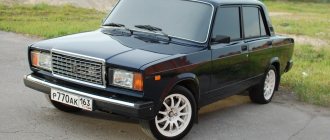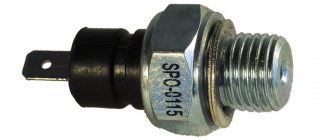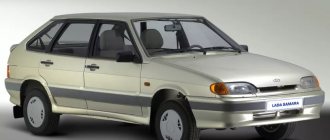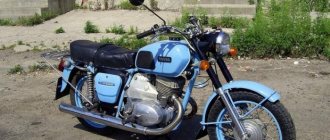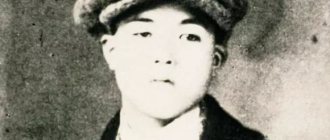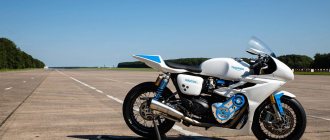Just add doors: development history and secret of success of the VAZ-2109
Remembering the Finnish Eurosamara Lada Baltic and the four-door sedan VAZ-21099, we slightly ignored the “basic source” - the five-door hatchback VAZ-2109. But in vain, because this model has become a real long-liver among all front-wheel drive vehicles of the eighth family, surpassing even the basic VAZ-2108 in the number of production years and cars produced, which we have repeatedly tested in various trim levels, including the “maximum”. So, today we will remember the history of the appearance and the secret of the unfading popularity of “zero nine”.
VAZ 21099
The idea of creating a sedan based on the 2108/2109 models haunted the creators from the very moment they were launched into series. The fact is that in the USSR, even in the 80s, a car was still a luxury and the buyer preferred modern Samaras to the time-tested “classics”, which had a more spacious trunk and a comfortable interior.
In this regard, VAZ management constantly received letters from Soviet car enthusiasts demanding the release of a new sedan. In Togliatti they listened to these requirements and in 1990 launched the Lada 21099 into mass production.
Soviet motorists greeted the new product with undisguised delight. After all, it met all the necessary requirements at that time - the presence of a spacious trunk, as well as acceptable comfort due to two additional rear doors.
Car history
In 1987, the first “nines” rolled off the assembly line, displacing the then popular eight. The five-door hatchback, with its sporty appearance and excellent dynamics and handling, won the hearts of millions. Against the backdrop of exorbitantly priced and still rare foreign cars, the VAZ 2109 looked very profitable.
“Nine” gained fame abroad. In Russia, both young people and their parents dreamed about it equally. A reliable and safe car, unpretentious in maintenance, has firmly taken its place in the hearts of car enthusiasts. And after the motor rally from Moscow to Lisbon, the VAZ 2109 became simply an idol in its country and the CIS countries.
Presentation of the Lada 99 model
The model is represented by a sedan body, designed for 5 seats, and has 4 doors. Its prototype is VAZ-2109. It was its appearance that was almost completely copied with only one difference: a trunk characteristic of a sedan appeared. Due to this, the car increased in length.
The Lada 99 car was legendary in the 90s. The car participated in almost all films. At that time, this model was considered the most prestigious; in films, “new Russians” rode around in it. We can say that such advertising played a big role in increasing demand for the VAZ-21099. The car was produced for export, however, under a different name. There it is better known as Lada Forma.
The four-door Lada 99 sedan differs from its predecessors in length, as it has been increased by 20 mm. The first lines of the Samara brand are completed by this machine. Production of the car began in 1990 and continued until 2004. Despite the fact that the Lada 99 was soon replaced by new models, it still remains the most common in the CIS and is one of the inexpensive but practical cars.
Generations 2109
1987
2109
1987
21091
1987
21093
1994
21093i
1996
Baltic
Model history
“Nine” was produced at AvtoVAZ from 1987 to 2004. Then she connected her life with Ukraine, where at the facilities of the automobile giant in Zaporozhye, until 2011, assembly was carried out from supplied vehicle kits of the third modification of VAZ 2109 . Almost a quarter of a century of the active phase of life means that for at least the same time it will be possible to see the “nine” on highways or city streets.
- The previous “eight”, which opened the family of “Samar” and “satellites”, was exceptionally good, but the presence of only 3 doors brought back memories of the same 3-door “Zaporozhets”, the image of which did not correspond to the concept of prestige.
- The use of almost the same technical solutions and units, placing them in a full-fledged 5-door hatchback body, resulted in the VAZ 2109 , which during production slightly changed several times externally and internally, reproduced its modifications, but was still in is basically constant.
Photo Lada 2109
Photo VAZ 2109 - rear view
Reliability
VAZ 2109 was considered a reliable and safe car. And thanks to the availability of spare parts, it was not difficult to repair it. This workhorse easily overcame any difficulties even when fully loaded. After all, at the time of its appearance, not everyone could afford a car, and therefore relatives with personal cars were mercilessly exploited. And add here the poor quality of roads and we get an ideal workhorse that overcomes any difficulties.
Even now it is recommended as a first car or a car for a summer residence, since the latest generation of the “Nine” costs the money for which, even if you can buy a foreign car, but it’s absolutely dead and then you still have to look for spare parts for it.
“Nine” took a whole milestone in the history of Avtovaz and the whole country. They sang songs about it on stage, and participated in races and international car rallies. This car was the cherished dream of many and could be seen in films more often than other domestic cars. The legendary VAZ 2109 was replaced by the no less stylish VAZ 2114, and then by the Priora. But the “nine” will forever remain in the hearts of the 90s generation as the best car of that time. And despite the fact that production of the “nine” has long been discontinued, it is still on the list of leaders on the secondary market.
Technical characteristics of VAZ 2109
Performance characteristics of the VAZ 2109 nine
Maximum speed: 160 km/h Acceleration time to 100 km/h: 13 sec Fuel consumption per 100 km in the city: 10 l Fuel consumption per 100 km on the highway: 5.7 l Fuel consumption per 100 km in the combined cycle: 7.3 l Fuel tank volume: 43 l Vehicle curb weight: 945 kg Permissible gross weight: 1370 kg Tire size: 165/70 SR13
Engine characteristics
Location: front, transverse Engine capacity: 1500 cm3 Engine power: 78 hp Number of revolutions: 5400 Torque: 115/3000 N*m Power system: Distributed injection Turbocharging: no Gas distribution mechanism: OHC Cylinder arrangement: In-line Number of cylinders: 4 Cylinder diameter: 82 mm Piston stroke: 71 mm Compression ratio: 9.9 Number of valves per cylinder: 2 Recommended fuel: AI-95
Brake system
Front brakes: Disc Rear brakes: Drum
Steering
Steering Type: Rack and Pinion Power Steering: No
Transmission
Drive: Front Number of gears: manual gearbox – 5 Gear ratio of the main pair: 3.9
Suspension
Front suspension: Shock absorber Rear suspension: Coil spring
Body
Body type: hatchback Number of doors: 5 Number of seats: 5 Vehicle length: 4006 mm Vehicle width: 1650 mm Vehicle height 1402 mm Wheelbase: 2460 mm Front track: 1400 mm Rear track: 1370 mm Ground clearance (clearance): 160 mm Maximum trunk volume: 1000 l Minimum trunk volume: 270 l
Production
Year of manufacture: from 1987 to 2006
Specifications
The table below shows the technical characteristics of the main modifications of the VAZ 2109 car:
1. VAZ 2109 “Sputnik” A car with a 1.3 liter carburetor engine
2. VAZ 21093 “Samara” The car was produced with a 1.5 liter carburetor and injection engine
3. VAZ 21093-22 Lada Samara Baltic GL Export version of the car. In terms of technical characteristics, it is practically no different from the VAZ 21093
VAZ 2109 "Sputnik"VAZ 21093 "Samara"Lada Samara Baltic GL (21093-22)GeometryNumber of seatsEngineTransmissionSuspension and steeringSpeed characteristicsBrake systemPerformance characteristics
| Modification name | VAZ 2109 | VAZ 21093 | VAZ 21093i | 1500 GLi/Li |
| Year of release | 1987 | 1990-2004 | 1994-2004 | 1996-98 |
| Body type | Hatchback | Hatchback | Hatchback | |
| Number of doors | 5 | 5 | 5 | |
| Steering wheel position | left | left | left | |
| Wheelbase | 2 460 mm | 2 460 mm | 2 460 mm | |
| Ground clearance | 160 mm | 160 mm | 140 mm | |
| Dimensions / Length | 4,006 mm | 4,006 mm | 4,046 mm | |
| Dimensions / Width | 1 650 mm | 1,620 mm | 1,620 mm | |
| Dimensions / Height | 1,402 mm | 1,402 mm | 1,402 mm | |
| Track / Front | 1 400 mm | 1 400 mm | 1 390 mm | |
| Track / Rear | 1 370 mm | 1 370 mm | 1 360 mm | |
| Weight/Curb | 915 kg | 915 kg | 945 kg | 1,030 kg |
| Weight / Gross | 1,340 kg | 1,340 kg | 1,370 kg | — |
| Total | 5 | 5 | 5 | |
| Name | VAZ 2108 | VAZ 21083 | VAZ 2111 | VAZ 1.5 |
| Location | front | front | front | |
| Orientation | transversely | transversely | transversely | |
| Supply system | carburetor | carburetor | injector | injector |
| Cylinders/valves | R4/2 | R4/2 | R4/2 | |
| Cylinder diameter | 76 mm | 82 mm | 82 mm | |
| Piston stroke | 71 mm | 71 mm | 71 mm | |
| Compression ratio | 9,90 | 9,90 | 9,90 | |
| Volume | 1,288 cm? | 1,499 cm? | 1,499 cm? | |
| Power | 64 hp at 5600 rpm | 70 hp at 5600 rpm | 78 hp at 5400 rpm | 71 hp at 4800 rpm |
| Torque | 94 Nm at 3500 rpm | 106 Nm at 3400 rpm | 116 Nm at 3000 rpm | 118 Nm at 2400 rpm |
| Fuel brand | AI-93 | AI-93 | AI-95 | AI-95 |
| Drive unit | front | front | front | |
| Clutch | Single disc, dry | Single disc, dry | Single disc, dry | |
| Transmission | Manual transmission 5 gears | Manual transmission 5 gears | Manual transmission 5 gears | |
| Steering type | rack type, without amplifier | rack type, without amplifier | rack type, without amplifier | |
| Maximum speed | 148.0 km/h | 156.0 km/h | 155.0 km/h | 156.0 km/h |
| Acceleration up to 100km/h | 16.0 sec | 13.5 sec | 13.0 sec | 12.5 sec |
| Front brakes | disk | disk | disk | |
| Rear brakes | drums | drums | drums | |
| Turning diameter | 11.0 m | 11.0 m | 11.0 m | |
| Fuel tank volume/main | 43 l | 43 l | 43 l | |
| Trunk volume / min | 330 l | 330 l | 330 l | |
| Trunk volume / max | 640 l | 640 l | 640 l | |
| Fuel consumption / in the city | 8.6 l/100km | 8.7 l/100km | 9.9 l/100km | 10.0 l/100km |
| Fuel consumption / on the highway | — | — | 6.2 l/100km | |
| Fuel consumption / mixed mode | — | — | 7.5 l/100km | |
ENGINE
In the role of motors, domestic engineers used various power plants with different volumes and power. The very first Soviet-made models came with a 1.1-liter engine.
The basic version of the “nine” was equipped with a 4-stroke, eight-valve, four-cylinder power unit of the “eight”, the displacement of which was 1,295 cubic centimeters. This “engine” developed 64 horsepower at 5,600 rpm. Peak torque (94 Nm) reached after 3,400 rpm.
The speed limit was 148 kilometers per hour. The first hundred was reached in 16 seconds. Such a modest engine consumed about 8.7 liters per hundred kilometers in city mode and 5.7 liters outside the city.
Option 21093 already has a carburetor engine 21083. It has a volume of 1,499 cubic centimeters. Maximum power of 69 “horses” is achieved after reaching 5,600 rpm. The maximum torque is 106.4 Nm already at 3,500 rpm. The Soviet hatchback can accelerate to 155 kilometers per hour, and the first hundred is reached in 15 seconds.
It is logical to conclude that as power increases, gasoline consumption also increases. So, in the city this figure remains at 8.6 liters per hundred kilometers, and on the highway it drops to 5.9 liters per 100 kilometers. The VAZ 2109 carburetor was called “Solex” and was a new, more economical model.
The most compact is considered to be the 1.1-liter engine, developing only 54 “horses”, which were available at 5,600 rpm. Maximum torque of 79 Nm is available at 3,600 rpm. The maximum speed does not exceed 155 kilometers per hour, and fuel consumption in combined mode is about 6.7 liters per 100 kilometers.
In addition, later they began to produce the VAZ 2109 engine with an injector. It received the index 211180 and was installed in the VAZ-21093i and 1.5 liter volume. This power unit is capable of producing 72 horsepower, available at 5,600 rpm.
Peak torque of 118 Nm is available at 2,800 rpm. For every 100 kilometers, the fuel consumption of the VAZ 2109 is 8.0 liters in the city and 5.8 liters on the highway.
TRANSMISSION
The gearbox for the hatchback initially came with four speeds, but since 1989, the engineering staff decided to introduce a five-speed manual transmission. This transmission has a single-plate simple clutch, a cylindrical final drive, a bevel differential and drive shafts with CV joints.
There is also an integrated center spring and cable drive. The VAZ 2109 gearbox is not very complicated, so some even undertake to repair it on their own.
The design of the Soviet front-wheel drive hatchback has an interesting feature. In order to engage reverse gear, move the gearshift lever all the way to the left and forward. Almost the same principle applies to turning on the first speed.
CHASSIS
At the front, they decided to install a fully independent McPherson-type suspension, which is also called a “floating spark plug.” At the rear they installed a semi-independent suspension with a transverse beam that works on torsion.
In its structure, such a beam is similar to numerous front-wheel drive cars of past years. Hydraulic shock absorbers, cylindrical springs, as well as lower wishbones with braces and a stabilizer bar are used.
As a braking device for a front-wheel drive car, disc brakes with movable calipers in front and drum mechanisms in the rear are used. The distance between the disc and the pad is adjusted automatically. The brake drive of the machine is represented by the hydraulic method.
Salon
Especially for the new series of cars, the Volzhsky Automobile Plant abandoned the Zhigulevsky exterior, creating a completely new interior. The car is arranged so that the driver can easily and comfortably reach everything. The model has 3 types of panels: high, low and euro. In the luxury configuration, the car was equipped with electric windows. It is worth noting that the seats have now become more comfortable, which contributes to a more comfortable ride. The rear sofa is small, as it was intended for children, but in the dashing 90s, 2-3 large guys could fit there.
This is an ideal car for a novice driver and work. The car is characterized by high maintainability, inexpensive parts and wide scope for tuning the interior, engine, and appearance.
SAFETY
The dashboard takes impacts tightly. The controls, along with the headrests and other elements, were made of soft plastic. The factory provided sun visors, so as not to blind the driver, which were covered with cladding. Additional sun protection is provided by easily adjusting the placement of the interior mirror.
The plant workers provided a system of mutually moving elements that absorb the impact force, combined with a carriage that moves to one side, which, using an adjustable delay, reduces the collision energy with the steering wheel. The aspherical concave external mirror increases the viewing range.
Estimating the distance to the car following behind will only be symbolic, since there is a slight distortion. The designers of the VAZ 2109 provided seat belts not only in the front seats, but also for those sitting in the rear. Such an element can save more than one life!
The car received three-point seat belts, with an automatically winding device and a locking device, which provides full independence of activity at a calm speed mode, while at the same time clasping the torso tightly and with tension.
During strong acceleration or deflection of the machine, the belt is quickly locked in all directions. This option is not tested by special sudden movements of the body.
Door panel decor
Door trims are a favorite field for interior design. For VAZ 2109 they are simple or include fabric sections. Tuning of the latter is primitive: after dismantling, the base is covered with material to match the chairs, and the element is installed in place. The decoration of the “standard” panels is based on the independent production of similar inserts. It is necessary to remove the patterns from all the recesses, cut out fibreboard podiums along them, pasting them with leather on a layer of synthetic padding. You will get pads blown on one side and attached to the profile with construction adhesive. The catch is the recesses for the handle and gate of the window lifter, the coordinates of which are better not to be mistaken.
Some craftsmen manage to cover the entire door panel, but along with similar tuning of the central panel and ceiling tiles, the operation is meaningless. Objective factors here: very complex shape, large surface area, temperature changes, frequent mechanical impact. Subjective – installation using heating devices is extremely labor-intensive, and no matter how competently the work is done, sooner or later the coating will begin to lag.
Design differences
What is the difference between 2109 and 21099?
Even though these two cars are very similar, there are still some differences between them.
So, 21099 had the following features:
- A different radiator grille configuration.
- Instrument panel with a tachometer (early versions).
- The rear overhang of the body has been increased by 20 centimeters.
Variations
VAZ 2109 and 21099 had modifications with identical technical characteristics.
Therefore, it is more logical to present only the power units with which these models were equipped:
- The engine is 1.3 liters with an output of 64 horsepower.
- The engine is 1.5 liters, producing 70 horsepower.
- Installation of 1.5 liters with fuel injection system. Develops 78 “horses”.
All engines were equipped with a five-speed manual transmission.
It is worth noting that later versions of Lada 21099 received a 1.6 liter engine that produced 81 horsepower. In addition, its power range lacked a 1.1-liter unit, which was equipped with both the Nine and Eight.
Trial
Nothing extra
These two cars look quite attractive. Their design is devoid of provocative solutions, but it is harmonious and thoughtful. “Nine” has a more rapid body profile, while 21099 is more sedate and respectable.
In terms of geometric cross-country ability, the 2109 has a slight advantage due to shorter body overhangs. But driving over potholes on the 21099 is more problematic due to the long stern.
Comfortable and cozy
The interior of both Samaras is identical. It is worth mentioning in advance that the quality of finishing materials is far from ideal - hard, echoing plastic everywhere. Of course, plastic made it possible to reduce the weight of cars, but it deprived VAZ models of that touch of luxury for which the Zhiguli of the classic family is famous. At the same time, the ergonomics are good and you don’t have to be distracted from the road thanks to the compact layout of the controls.
Elastic front seats provide good body support. However, a tall driver will complain about the lack of adjustment of his seat in the longitudinal plane. Only two passengers are comfortable on the back seat, provided their height is less than 175 centimeters.
As for the luggage compartment, there are differences between 2109 and 21099. The “Nine” has a trunk volume of 270 liters, while its more practical companion platform has this figure already equal to 400 liters.
Love 24 years long
“Nines” almost immediately appeared in the showrooms of European Lada dealers, and very rarely - in authentic form. To please the jaded Western consumer, dealers equipped the cars with music, alloy wheels and exterior decorative elements.
They often reupholstered interior elements and changed the steering wheel, trying to make the five-door Samara more attractive in the eyes of a potential buyer.
| At a minimum, caps and a different radiator grille are what distinguished the export European “nine” from the Soviet one |
| European dealers even reupholstered the interior with a different fabric, improving the lateral support of the seats! |
| In the “top” versions, the front seats could be completely replaced |
French, Belgian and English importers went even further, installing an aerodynamic body kit on the Nine with new elements such as a spoiler on the trunk lid.
| Some dealers even customized their own identification plate! |
New optics were also not uncommon - for example, the four-headlight French Morette or the German Hella. Well, the radiator grille on the “short wing” was changed on almost 100% of dealer VAZ-2109s.
The success of the “nine” in Europe was also facilitated by an unusual “promotional event,” as they would put it in our time. Soviet auto journalists (and a few motor sportsmen) from the Za Rulem magazine decided to “catch up and overtake” the Portuguese, who in 1986 arrived from Lisbon to Moscow in 51 hours and 30 minutes.
| The cover of the January issue of “Behind the Wheel,” as well as the spread, is dedicated to the run of Soviet auto journalists from Moscow to Lisbon in a cherry-colored VAZ-21093 |
"Our Answer to Chamberlain" took place in September 1988. Of course, the ambitious trans-European marathon “Moscow-Lisbon” was preceded by serious preparation at the state level: the development of the diet and training of the crew was undertaken at the Research Institute of Medical and Biological Problems of the USSR Academy of Sciences. It was decided to drive the “best of the best” - that is, a one and a half liter “nine” with a five-speed gearbox. A thoroughly run-in (but still production) car with Michelin tires on Melber alloy wheels and a Hella rally “chandelier” on the front end managed to “fly” from the 50th Anniversary of October Square in the center of Moscow through the entire then ununited Europe to the gates of Lisbon in 45 hours, covering 4,811 km at an average speed of 107 km/h. The constant actual speed for a third of the way was 150-170 km/h. It is not surprising that the dusty cherry “nine” took pride of place in the Lada exhibition at the Paris Motor Show, impressing visitors with its achievement. True, the French importer asked VAZ to remove the “1500” nameplate from the trunk lid, since this version of the Samara had not yet been delivered to Europe.
But even in the already dying USSR, the five-door version was treated with warmth and respect. Yes, it’s smaller than a Zhiguli, but it’s so modern, dynamic and maneuverable! And at this time at VAZ Samara they just started painting with newfangled metallics. Many young readers will find it difficult to understand the level of “coolness” of the latest Lada model, the color “wet asphalt” or “currency”... It is not surprising that strong young people of athletic build, dressed in leather jackets, who became masters of life for a while, immediately chose the “nine” as a “a vehicle for every day”, driving around in prestigious new VAZ-21093 to their “arrows”, “showdowns” and simply to collect tribute from market entrepreneurs.
The new VAZ models of the tenth family have somewhat damaged the prestige of the “zero ninth”, but not so much that it was immediately abandoned in favor of a “crude” and not so “driver” new product. The phenomenon of the success of the five-door “nine” was that it suited both “bandos” and ordinary Russian citizens equally well. And the Europeans still used the “nine” - albeit in the form of an updated Lada Baltic, produced for a couple of years at the Valmet plant in the Finnish city of Uusikaupunki.
But for the domestic market, they began to prepare a replacement for the “chisel” - more precisely, an update in the form of Samara-2, modernized inside and out.
| The version of the VAZ-21093 with distributed injection could be identified by the 1500i nameplate |
Having managed to try on the “injection” engine of the VAZ-2111, the five-door Samara in a long-winged guise and with a high panel lasted on the assembly line in Tolyatti until 2004, giving way to the “four”. But the life path of the “nine” did not end there: from 2004 to the end of 2011, the VAZ-21093 was produced from vehicle kits at the Ukrainian AvtoZAZ plant. Thus, the “zero ninth” was produced for almost 25 years, while the VAZ-2108 was produced for twenty. And the five-door Samaras produced in Togliatti alone were twice as many as the “zero eights” - more than one and a half million VAZ-2109s against 884 thousand “eights”.
ADVANTAGES OF THE MACHINE
- Inexpensive Soviet-made car;
- Front-wheel drive can certainly be considered an advantage;
- Acceptable ride height;
- Good dynamics, high speed, pleasant handling and sufficient stability on different surfaces;
- Heating and ventilation cope well with their tasks and supply air to several points at once, which improves the uniform distribution of thermal air throughout the cabin;
- Acceptable fuel consumption;
- Ideal for tuning;
- Availability of spare parts and good maintainability.
DISADVANTAGES OF THE CAR
- Corrosion of metal;
- The appearance is clearly not for everyone;
- A small resource of some details;
- Mediocre sound insulation of the cabin;
- Low equipment;
- There is very little free space, especially for rear passengers;
- Small luggage compartment;
- Poor maneuverability;
- Poor quality interior;
- Low level of security;
- The power unit clearly lacks power.
Sources
- https://www.kolesa.ru/article/prosto-dobav-dverej-istoriya-razrabotki-i-sekret-uspeha-vaz-2109-2
- https://vazweb.ru/info/vaz-2109.html
- https://www.syl.ru/article/226693/new_lada—legenda-otechestvennogo-avtoproma
- https://www.drive2.ru/cars/lada/2109/m1498/
- https://kuruh.ru/vaz-2109-devyatka
- https://vaz-2109.ru/texnicheskie-xarakteristiki.html
- https://zen.yandex.ru/media/all_auto/istoriia-vaz-2109-tehnicheskie-harakteristiki-foto-video-polnoe-opisanie-5b1d170bbce67ee9778d5da1
- https://autoiwc.ru/lada/vaz-2109.html
- https://AutoVogdenie.ru/lada-vaz-2109-21099.html
- https://www.drive2.ru/cars/lada/2109/g2173/
- https://fishki.net/auto/3339038-rannjaja-devjatka-vaz-2109-s-dlinnym-krylom-1990-goda-vypuska.html
Trunk nine
The value is rather nominal, giving the right to assert: “He exists.” It includes either a suitcase, or a couple of travel bags, and three buckets. When installing gas equipment with a cylindrical cylinder, it disappears completely, although there is useful space for tuning there too. The main, and perhaps the only, opportunity to transform the luggage compartment is to install a subwoofer and speaker amplifier. The process looks like this:
- A speaker box is assembled from chipboard or plywood;
- the wiring is laid, the subwoofer is attached;
- the internal cavity of the trunk is lined with kapert - a gray fleecy automotive fabric similar to a rug;
- The amplifier is mounted on top.
The composition looks gorgeous, especially if backlit. The car “sounds”, and there is only one problem: you have to sacrifice the spare tire due to the inability to access the recess on the bottom of the compartment.

